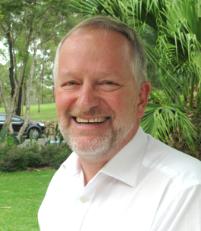NBN and mobile networks need to work in tandem, says man who enabled Nextgen project
Published on 16 February, 2011
CQUniversity's Richard Egelstaff is well-placed to comment on whether improved wireless networks are a threat to viability of the federal government's National Broadband Network (NBN).
Before arriving at Rockhampton*, he had a pivotal role pulling together the consortium behind the billion-dollar Nextgen project.

Richard Egelstaff
Nextgen developed a national optic fibre network of approximately 8400km in length, extending from Brisbane to Perth via Sydney, Canberra, Melbourne and Adelaide, and could be one of the backbones of the huge NBN project envisaged as Australia's largest-ever infrastructure program.
Despite enabling the NBN infrastructure consortium, Richard believes "we don't need NBN in every town, village, or hamlet in Australia".
"We do need NBN in every major conurbation that contains, a hospital, university, factories, offices, and people in fixed locations who need to use the (highest-speed) ‘applications'."
Richard says it's essential to understand that Telstra's copper network is inadequate and needs replacing, and it's substantially cheaper to replace the network with fibre. It's also substantially cheaper to maintain a fibre network over a copper network.
"For fixed locations, NBN is essential, for example universities, hospitals, businesses and people that spend most of their communication in a fixed location (i.e. students doing university courses from their bedroom).
"For people that require mobility, NBN is no help and Telstra's 4G mobile network announcement is fantastic.
"The real issue is, what are the applications that are going to run on NBN or Telstra 4G?"
Richard says hospitals can connect fixed location life-monitoring equipment and send real-time information to experts in other hospitals elsewhere in the country.
Similarly, universities can provide a socially-rich education experience to students that is comparable to a classroom, regardless of where the student is located (but it's better for them to be in a fixed location).
Factories can communicate with their customers to provide prototypes, machine settings and samples, in real time, and thus achieve reduced cost, fast turnaround, better quality and reduced risk.
Offices can reduce the impact of global warming by not flying from city to city and instead conduct socially-rich conferences between their staff regardless of their location.
"And American entertainment moguls can obtain intensely detailed real-time backgrounds for their news stories of cyclones or other catastrophic events," Richard says.
"If NBN is constructed in the right way then it is almost infinitely upgradeable - but we will be upgrading it - there is no solution that is the final solution!
"Telstra 4G is fantastic for every conurbation, town, village and hamlet and proves that you don't need NBN for everyone!
"We need both NBN and Telstra 4G to function in the 21st century and run the applications, achieve the lifestyle, reduce global warming and meet the aspirations of the people.
"The debate must change to start discussing the applications that are going to be used on high-speed broadband and which of those applications need fixed location (NBN) and which require mobility (Telstra 4G, 5G, 6G, 7G, ++)."
* Richard is a PhD candidate interested in the intangible benefits of 'change agents' within companies. He's also a Senior Lecturer in Railway Systems for CQUniversity's Centre of Railway Engineering and is the Manager of Learning and Development for Rail Innovations Australia, also based in Rockhampton.

